The Rockefeller Foundation makes moves in sub-Saharan Africa

A landscape in sub-Saharan Africa Shutterstock
Comunilife has opened a new supportive and affordable housing project in Brooklyn. NY1 has the details on the 89-unit development in the Bed-Stuy area of the borough, which includes 54 studio apartments for formerly homeless adults with special needs. Amenities include a community room, computer lab, on-site case management, and social services.
The Bronx-based Sauti Yetu Center for African Women has won a $100,000 contract from the New York City Department of Social Services. The one-year contract will fund culturally and linguistically direct services to African workers migrant families, according to the City Record. Mount Sinai Hospital will provide $156,250 worth of mental health services to adolescents and $193,032 worth of health care services on behalf on the city Department of Health and Mental Hygiene.
How do you bring joy to your donors? GuideStar has a few suggestions in a new post on its website. The post also has some ways to “declutter” your approach. “Look through one of your fundraising appeals, but don’t ask yourself whether it gives you joy. Instead, ask yourself – more importantly – whether each part of it gives your donors joy. That’s what counts.”
LAPA has some ideas of its own on how to secure a meeting with prospective donors – with examples of how to respond to common excuses.
The Rockefeller Foundation is moving forward with its support of a food insecurity initiative in sub-Saharan Africa. Foundation president Rajiv Shah was on hand as California-based Atlas AI and the Alliance for a Green Revolution in Africa signed a memorandum of understanding on the initiative, which is supported by the foundation. Read all about the effort here.“The MOU establishes an agreement between both Atlas AI and AGRA to collaborate around predictive analytics for smallholder agriculture,” reads a press release, “through applications of satellite imagery and machine learning to offer useful insights in areas of land use, yields, and peak time for harvest, input distribution gaps, and other contextual monitoring aspects.”
It was my pleasure to welcome @vscoleman to formalize @atlasai_co's @AGRAAlliance partnership at @RockefellerFdn yesterday. #Tech has the power to improve #foodsecurity that is critical for both human welfare & economic growth in Africa. More: https://t.co/SGJOCjq00v #data4good pic.twitter.com/BJVBufnpns
— Dr. Rajiv J. Shah (@rajshah) April 3, 2019
NEXT STORY: Public hospitals versus the VA